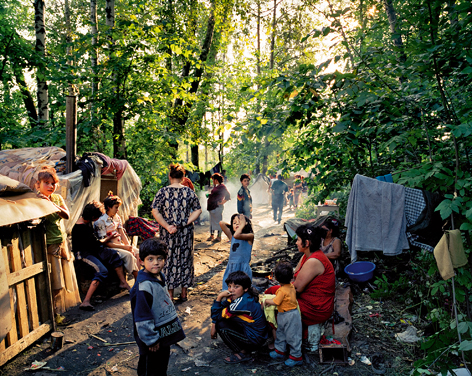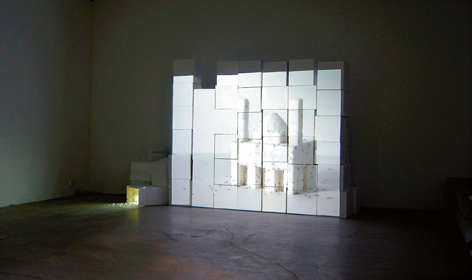|
|
| About Human Behavior in Finnish Style Inese Baranovska, art historian Variations on Transcending the Finiteness of Human Vision - exhibition of Finnish contemporary art 10.07.-23.08.2009. Riga Art Space | |
 Anu Pennanen. Sōprus - Дружба (Friendship). 3-channel video installation, S 16mm colour film transferred on DVD, 20:00 loop. 2004-2006. Publicity photo | |
| On 10 July, Riga Art Space in association with FRAME* (Finnish Fund for Art Exchange) will open an exhibition curated by Marita Munkunen. It has a very substantial and elaborate title - Variations on Transcending the Finiteness of Human Vision. A first version of this exhibition, with the title Five Variations on Transcending the Finiteness of Human Vision, was shown in 2008, in Belgrade. It now has been augmented specially for Riga Art Space, and has become a choir of many voices featuring works (photographs, video and installations) created mostly during the last decade by twelve authors: Adel Abidin, Joakim Eskildsen, Jaakko Heikkilä, Sasha Huber, Sanna Kannisto, Anu Pennanen, Harri Pälviranta, Sini Pelkki, Seppo Renvall, Jani Ruscica, Jari Silomäki and Toumas Laitinen. | |
 Joachim Eskildsen. The Roma Journeys. Series of C-prints. 40x48cm. 2001-2006. Publicity photo | |
| A quotation from the exhibition concept by the curator Marita Mukunen provides us with a line of thought to lead us through the exhibition: "So, let's give impetus to our imagination and think about movements on to other worlds. Let us use it to fly beyond borders, territoriality, mobility... Neither mobility, nor being tied to a certain area can automatically lead to freedom, alternative forms of aesthetics or politics. It is clear today that in art, as well as in society and politics, we should be shifting away from a nostalgic desire for territoriality, for some sort of original, origin of a community. Nothing but catastrophes have ever come of it so far. What flight-paths might we take, however, when the common sense of our day tells us that people are ego-driven, strategically dishonest and combative individualist consumers? As in Malthus' horrific theory of biological fratricide (the ideas that inspired a corrupt social Darwinism, which laid the foundations for two world-wide wars) we assumed ourselves to be fighting for limited resources and a monopoly of power: all of us, always. Our faculties of dreaming and the aesthetic life of the senses can enable us to see, hear, smell, taste, feel, think, want, act, and love to create other worlds. "Only imagination can show us what to be," said the poet André Breton. Step after step, getting to know the original works as the show was being installed, I became increasingly more convinced by the mission statement of the exhibition as expressed in words: it was precisely about the real presence of the works of art themselves and their suggestive power, which cannot be matched, neither by textual explanations nor any electronic version. You simply have to see the exhibition. Before the opening of the exhibition I asked Munkunen to answer some questions, thus hoping to help the viewer to discover the guiding principle behind the exhibition. | |
 Adel Abidin. Tasty. Video installation. Two videos. 06:30, 1:00, loop, dimensions variable. 2008. Publicity photo | |
| Inese Baranovska: How did you select the artists for this show? Marita Mukonen: This show is based on an exhibition that I curated for the Belgrade Photographic Centre in the summer of 2008, so in the main it consists of video, film and photography. For the Riga exhibition I invited an additional six artists. Many of the works in the exhibition relate both to the life of an individual and to the major battles of society and global politics, however sharp ideological disputes are left aside, the chief thing is to open the gates of our minds to poetic musing. Instead of presenting a straightforward didactic sermon, the works open up a new space for a multiplicity of meanings. Politics and poetics are interlinked, without pointing things out with primitive directness. Poetry contains the promise of hope, and each in their own way, the artists in their works reflect on the difficulty of seeing beyond marked paths and mental highways, of transcending physical boundaries to create new (political) spaces and alternatives. I.B.: What is your mission, working as a curator of contemporary art? M.M.: My mission is in the action, it is a process which is connected to ongoing changeability in art, and in society as a whole. Now that the bubble has burst, after the excesses of high financial rates and short-termist thinking in art as much as in economics and politics, we can reconsider our place in the context of a wider history. Many positive and progressive achievements of today are related to major trends in the past, which, no doubt, are to be respected. But in today's post-communist and post-neoliberal vacuum we have to find new paths ourselves. At the moment I am interested in seeking in art a potential force for creating alternative political, social and economic movements, in thought as well as in practical action. What will the new movements of aesthetics look like, in the broadest sense, and what kind of art will be able to inspire development in other spheres? I.B.: How would you characterize the contemporary art scene in Finland today, in comparison with the international scene? How, in your opinion, do Finnish artists see themselves in this landscape? M.M.: I think that nowadays there is no one single global movement of art, rather there are several parallel global art movements, layers and networks. The raison d'etre for contemporary art and cooperation is built on the basis of fragmentary, inter-local, related and reciprocal processes. Several Finnish artists and art curators work internationally and in cooperation with various partners, and thus form a part of the very varied contemporary international art scene. Also, most of the works as seen in this exhibition have been created "on the way" to somewhere other than Finland. The global space is open to all takers, you just have to wish for it... * A play on words - the English word frame can have at least a dozen other meanings: build, structure, figure, physique, skeleton, carcass, a still from a movie, etc., which does not in the least restrict the mission of the organisation: it is a creative structure which ensures the effective movement of visual arts on the international arena by organising exhibitions and in-residence programmes for artists, and cooperating with museums and authors at the practical and professional level. /Translator into English: Sarmīte Lietuviete/ | |
| go back | |







